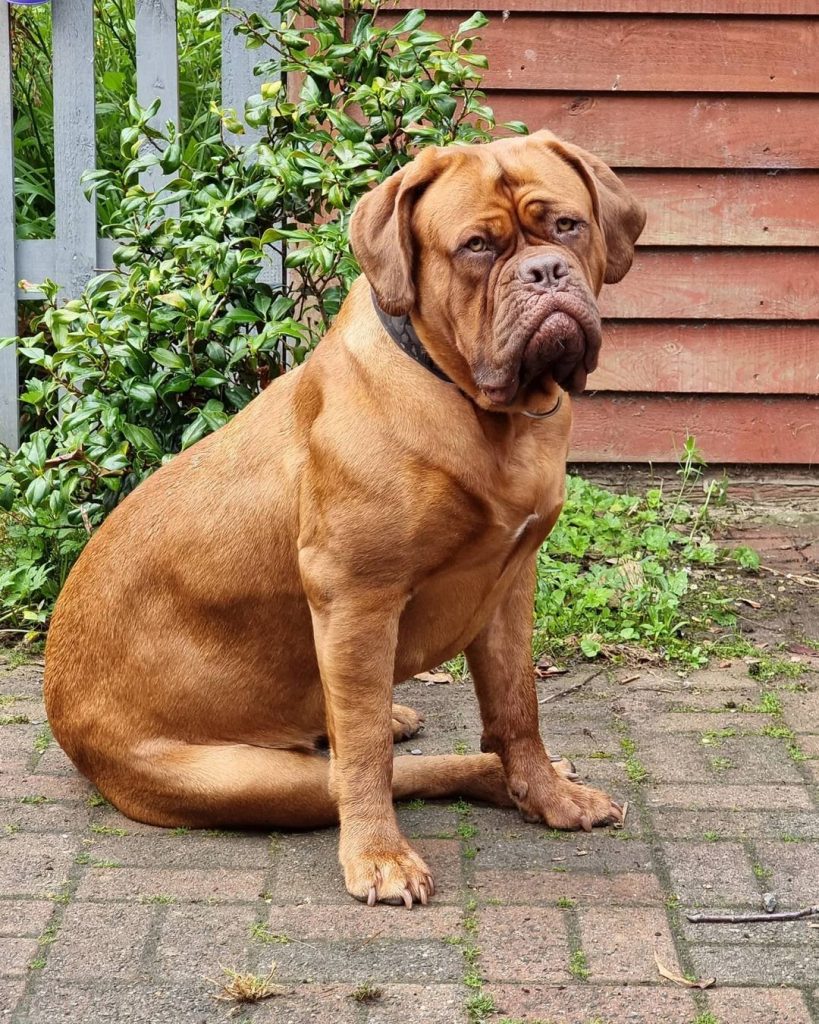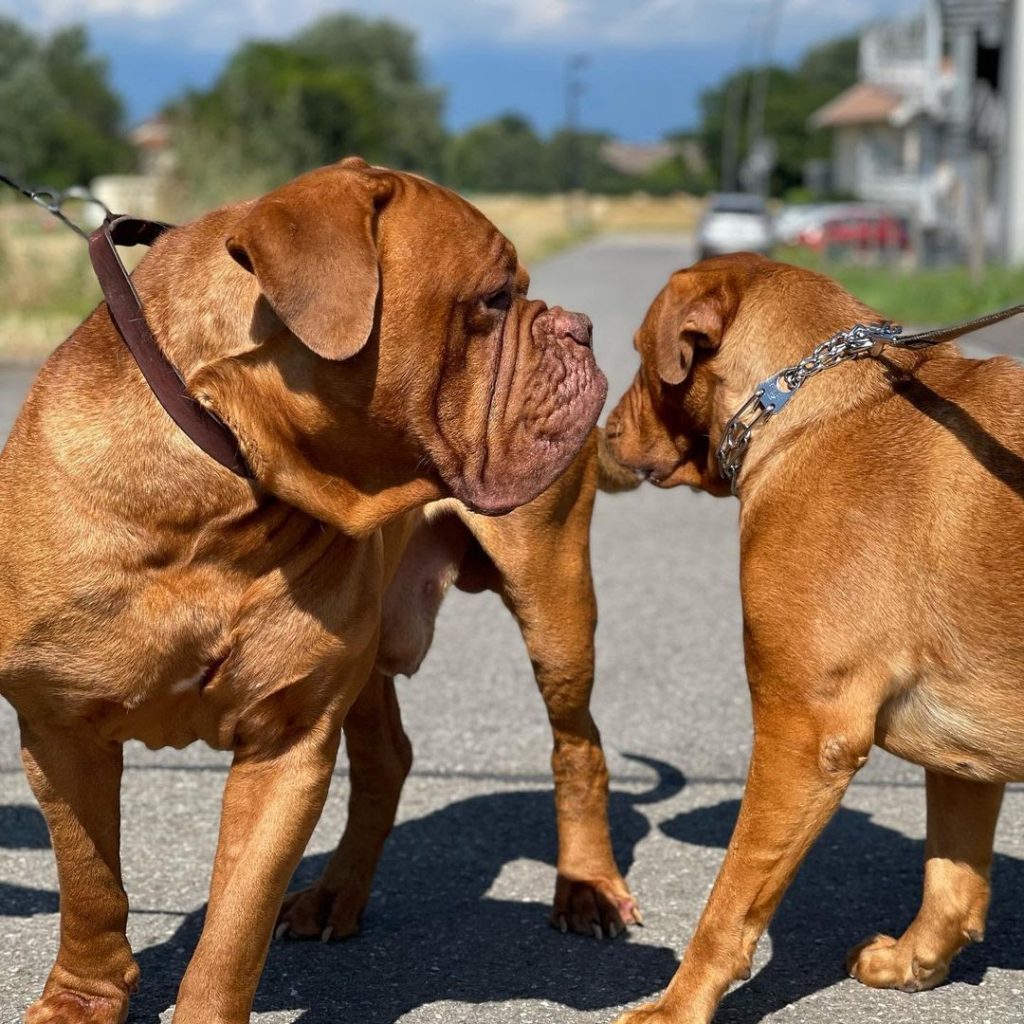French Mastiff vs English Mastiff: A Detailed Mastiff Comparison
Being a fan of the Mastiff family is not easy. There are so many breeds you can choose out of this ancient group and all of them are unique in characteristics and great in temperament. It is usually the French and the English Mastiff breeds which give prospective owners a hard time in choosing!
These two handsome four-legged lads are distinct from each other. You must learn first how these dogs came about, what their behavior will generally be like, as well as what their needs are. Only then can you decide which between the two will you ultimately favor at the start of your journey as a Mastiff owner.
Table of Contents
Breed Origins
French Mastiff


Some experts believe that the French Mastiff, also known as the Dogue de Bordeaux, is an ancient breed of France which developed hundreds of years ago. Its history remains to be unclear today, but due to his familiar features, many claim that he could be a close relative of the Bullmastiff and the Bulldog. Another theory says that the Tibetan Mastiff, Greek Mastiff, and the Neapolitan Mastiff could be his close forefathers.
Centuries ago, this dog has been widely utilized as a gladiator dog and warrior. In the 12th century, he was also popularly used as an elite hunter who would catch boars, wolves, and bears. In the middle ages, he transitioned as a cattle driver and a guardian of flocks.
Dogfighting and animal baiting didn’t spare this dog as well. This breed was commonly seen in wealthy French homes, yet he had his fair share of hardships and challenges as a canine. It was in the 1960s when the French Mastiff got further developed and along with it was his rising fame. He was recognized as an official breed, later on, by the American Kennel Club (AKC) in the year 2007.
English Mastiff


The English Mastiff comes from several lines of dogs who fought against lions, bears, and gladiators in the Roman arena. One of the important elements that were incorporated in the genetic formation of the English Mastiff was the Pugnaces Britanniae which started to exist at the time of the Roman conquest of Britain.
The Alaunt and the Molosser were also believed to be the English Mastiff’s genetic predecessors. When this Mastiff breed got introduced, his primary role in society was either to fight in battles just like his ancestors or guard his owner’s flock 24/7. His size was enormous when compared to other averagely-sized dogs which made him a desirable and suitable canine to ward off predators.
When this dog arrived in England, the British people found him a good fit, intimidating enough to guard large estates. He would be brought along by a human company at night, roaming and patrolling the area. In 1885, the AKC acknowledged the English Mastiff as a distinct dog breed and Bayard was the first one to be registered in the said organization.
Size, Appearance, & Coloring
French Mastiff


The French Mastiff is one of France’s strongest dogs. His build is muscular and well-proportioned. All his features combined which include a stocky figure and mild expression make him appear self-imposed. He’s got a harmoniously large and angular head, oval eyes that are set wide apart, small ears, and a muzzle that is short yet thick and powerful.
He’s got a cylindrical and powerful neck, a deep and broad chest, and well-angulated hindquarters and strong forequarters. The tail is thick and tapers only at the tip.
This French breed is ideally 23 to 27 inches in height and can weigh from 99 to over 110 pounds depending on the gender.
A healthy French Mastiff coat is short, soft, and fine to the touch. He’s available in fawn, mahogany, and red shades while the eye pigment and nose rims will appear brown.
English Mastiff


To state the obvious, the English Mastiff appears bulky as well but he comes in a much bigger package. He is full of strength and power yet his expression exudes gentleness and amiability. His stocky build is supported by muscular hindquarters that are quite angular and straight yet thick forequarters.
As to his facial features, he has a large, square head with a forehead that complementarily looks broad. His eyelids are muscled forming an arch on top of each eye. His jaws are strong and jowls hang loosely making him susceptible to uncontrollable drooling. His eyes are quite large and are usually brown.
Generally, the English Mastiff is 27.5 to over 30 inches in height. His weight ideally starts at 120 pounds to 230 pounds. Others have surpassed this range making this breed the largest of all.
His coat is dense and short and can be seen in three colors namely fawn, brindle, or apricot.
Temperament
French Mastiff
Putting into consideration that the French Mastiff is not only large but also an impressive canine, it is imperative that his temperament is stable and dependable. He shouldn’t get easily excited over things and must remain calm most of the time.
If raised well, the Dogue will show affection toward his owner and to the rest of the family. He might be naturally ideal as a guard dog but vigilance rather than aggression should be more prominent in his personality.
In certain cases, this French canine doesn’t like sharing his home with other pets. However, with thorough and proper socialization, his territorial instinct and prey drive will mellow drastically. If you have kids at home, this dog will surely love their company. He’s ready to have some fun, bond with people, and show them how a French Mastiff displays genuine love and care.
English Mastiff
The old English Mastiff loves good company every single day. He can’t bear being left alone with no one to interact with or he will show signs and symptoms of separation anxiety.
He is polite with everyone although visitors might be shaking around his presence. Other English Mastiffs may show timidity or shyness while others can be aggressive. This will all be factored in by how they were all treated during their puppyhood.
The only drawback of this canine is his incompatibility with families who have toddlers. It won’t be a good idea to let them play together considering how huge this dog is. Nevertheless, older kids can enjoy the experience of bonding with this colossal canine. He’s approachable, meek, and affectionate.
To lower his instinct to chase smaller animals, ensure that he’s familiar with your cats, rabbits, or other pets.
Trainability & Intelligence
French Mastiff


One thing to take note of about this French breed is that he’s strong-willed. He can never permit others to treat him as a pushover since he instinctively sees himself as the unpersuasive, dominant, highly intelligent, and independent boss. This calls for an owner who is strong in leadership and firm when it comes to training.
Bearing in mind his stubbornness, the French Mastiff is not great for first-time dog owners. This canine would need extensive and proper training as early as puppyhood to prevent him from becoming an aggressive dog. Moreover, his protective instinct soars high, so an early exposure to different faces must be done.
English Mastiff


While other dog breeds like to learn things fast, the English Mastiff goes by the saying, “slowly but surely”. This makes people assume that he is not a smart breed, but it is a highly wrong judgment. The English Mastiff is an intelligent canine, but at times, his stubbornness may show.
Just like the Bordeaux Mastiff, he’d need an experienced owner who will challenge him with new drills regularly. This dog will find it an insult if he gets to receive the same training every day and if it so happens, it will result in boredom which will eventually lead him to get distracted by other “more interesting” things.
Exercise Needs
French Mastiff
There’s no definite word to describe a French Mastiff when it comes to exercise. While some are keen to get moving, others would love to snuggle up with their owners and may tend to be very lazy. Anyhow, this dog can deal with a moderate level of exercise despite his big size.
Having a yard outside your home is an advantage that allows him to play with other dogs or sniff around. A short walk is ideal as well. An hour of exercise will do for him daily and this should never be compromised knowing that this breed is prone to gain weight.
English Mastiff
English Mastiff puppies are overly energetic. Despite their high levels of energy, it is not recommended to exhaust them nor incorporate rigorous exercise drills as these can, later on, damage their joints and bones.
While the pup matures, you can gradually increase the length of time for their activity. An adult Mastiff would typically need around an hour of sweating-off to keep him in shape. Although English Mastiffs are predisposed to be colossal, it’s still better to keep their weights down to keep them healthier.
Grooming Needs
There’s not much difference when it comes to the grooming needs of the English Mastiff and the Dogue de Bordeaux. Both would only need a bath when they got dirty or every 6-8 weeks. Nails should be trimmed when they are long or you can schedule it every month.
Since they are blessed with a short coat, both canines can only be brushed once per week. Their ears and teeth must be habitually checked for any signs of infection.
Health Problems
French Mastiff


France’s Mastiff breed is prone to several health issues which include:
- Elbow dysplasia
- Dilated cardiomyopathy
- Dental disease
- Obesity
- Infection
English Mastiff


No matter how healthy, the English Mastiff will still possibly acquire certain health conditions which can be:
- Hip dysplasia
- Hypothyroidism
- Cancer
- Subaortic stenosis
Breed Popularity
Mastiffs are becoming widely known in the US. Currently, the English Mastiff tops higher than the French Mastiff as he enjoys the 29th spot while the Dogue de Bordeaux consistently stays at the 67th ranking.
Fun Facts
French Mastiff
- He excels in dog sports!
- He originated in the Bordeaux region of France hence the name.
- The French Mastiff only enjoys an average of 5-8 years lifespan.
- Breeding this dog for appearance only started in the 19th century!
- In the movie Turner & Hooch, a French Mastiff was featured with Tom Hanks!
English Mastiff
- We almost lost this ancient breed due to scarcity of food during the two world wars.
- John Goodman, a 25-year old pilgrim, brought with him his English Mastiff on the Mayflower.
- The ancient Roman war dogs are his progenitors.
- The biggest litter on record was that of an English Mastiff mother who gave birth to a total of 24 pups!
- An English Mastiff was featured in one of Sherlock Holmes mysteries, “The Hound of The Baskervilles”.
Which Mastiff is Better?
There is a significant difference in the sizes of both breeds. The English Mastiff is great for families who are not only suitable for him personality-wise but also capable of feeding him loads of dog food daily. However, when it comes to energy, the French Mastiff has the edge. His smaller build enables him to withstand a more rigorous activity compared to that of the English Mastiff.
When it comes to temperament, the English dog is more docile while the French Mastiff is more serious when it comes to protecting his loved ones. Nevertheless, the English Mastiff is still a good guardian.
Evaluate thoroughly which dog you are capable of handling. Which one resonates more with the preferences of your family and kids? Once you’ve finally decided which one to adopt, share with us your experience!
